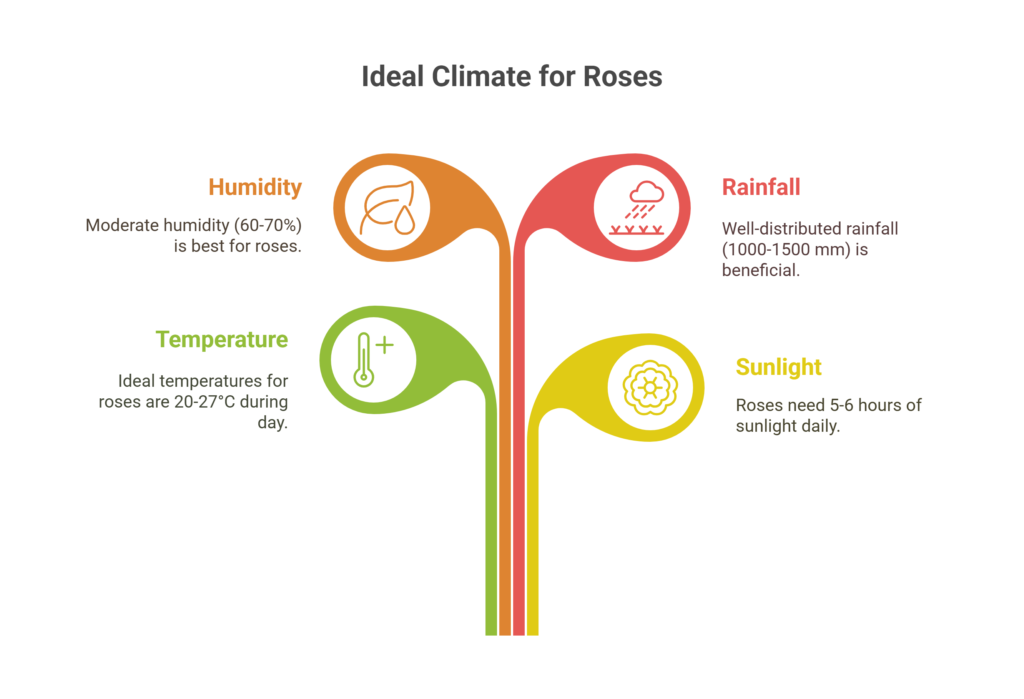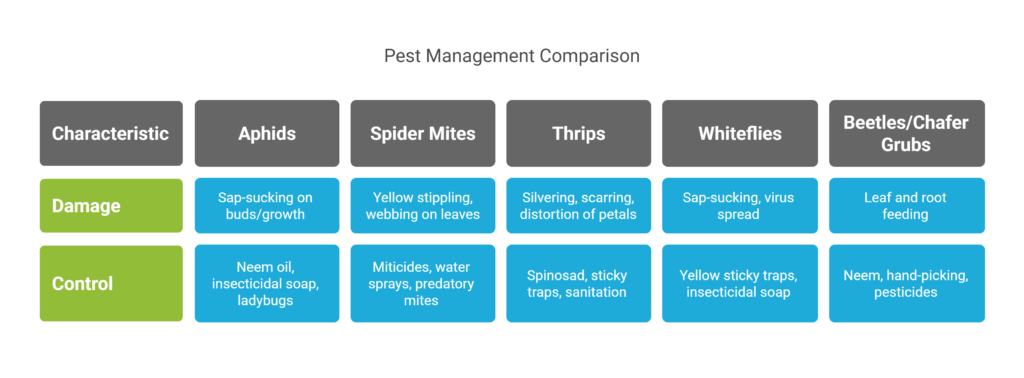Rose Farming
The profitability analysis of rose farming per acre for the first-year highlights promising financial returns. With a total revenue of NRs 500,000, generated from the sale of rose stems, and a total cost of NRs 340,000, which includes expenses for saplings, fertilizers, pesticides, labor, irrigation, and other operational costs, the farming venture yields a net profit of NRs 160,000.

This analysis demonstrates the potential of rose farming profit per acre as a viable and lucrative agricultural practice, especially when cost-effective management techniques are used to maximize yield. Deeper understanding of the farming operation’s long-term viability and profitability can be gained through additional examination of financial indicators such return on investment and gross profit margin.
Land Preparation
Land preparation begins with deep ploughing (12-18 inches) to break up hardpans, improve soil aeration, and allow deep root penetration. Following this, harrowing and leveling are essential to create a fine, clod-free soil tilth and ensure a level field for uniform irrigation and drainage. Concurrently, thorough removal of debris, including rocks, weeds (especially perennial roots), and previous crop residues, is critical. During the final ploughing, well-decomposed farmyard manure (FYM) or compost (15-20 tons per acre) is incorporated as a basal dose to enrich soil organic matter.
Soil Type
Roses can withstand soils with a pH of 5.5 to 7.5, although they thrive in slightly acidic to neutral soils (6.0–7.0). The best soils are loamy soils that are at least two feet deep, rich, and well-drained. Clay soils store nutrients but need additives for drainage and aeration, whereas sandy soils drain well but require more fertilizer and watering. Phytophthora and other root rot infections can be avoided with proper drainage. Soil structure, microbial activity, water retention, and nutrient availability are all enhanced by high organic matter (3–5% or more).
Climatic Requirements
Roses thrive under specific climate conditions. Ideal temperatures are 20-27°C (68-80°F) during the day and 15-18°C (59-64°F) at night. Flower production and quality suffer significantly if nights drop below 10°C (50°F), while sustained heat above 35°C (95°F) stresses plants, causing smaller, faded blooms.

Ample sunlight is crucial—at least 5-6 hours daily—for strong growth, plentiful flowers, and vibrant color; too little light results in weak, leggy plants with few blooms. Moderate humidity (60-70%) is best. Higher levels, especially with poor airflow, encourage fungal diseases (Powdery Mildew, Black Spot, Botrytis), though very dry air can also stress plants.
While well-distributed annual rainfall (1000-1500 mm) is helpful, water on flowers from rain or overhead irrigation damages blooms and spreads disease. Therefore, protected cultivation (e.g., polyhouses, greenhouses) is often preferred for reliable, high-quality cut flower production.
Major Rose Cultivars for Commercial Production
| Cultivar Type | Key Traits | Primary Use | Examples |
| Hybrid Tea (HT) | Long straight stems; Large, single, high-centered blooms; Highest market demand | Primary cut flower production | ‘Grand Gala’, ‘First Red’, ‘Polo’, ‘Nobel Star’, ‘Tineke’, ‘Konfetti’, ‘Sweet Akito’, ‘Topaz’, ‘Red Velvet’ |
| Floribunda (Fl) | Bushy plants; Cluster-flowered; Shorter stems | Landscaping, garden display, mass-market cuts | ‘Iceberg’, ‘Angel Face’, ‘Europeana’ |
| Spray Roses | Floribunda subtype; Harvested as full clusters | Specialty cut flowers (bouquets, arrangements) | ‘Golden Gate’, ‘Lovely Lydia’, ‘Red Spray’ |
| Cultivar Selection Factors | Market demand (color, bloom shape), disease resistance, climate adaptation, yield, stem length, vase life | Critical for profitability | N/A – Decision metrics |
Planting
Before planting, soil sterilization is important to suppress pathogens like fungi, bacteria, nematodes, and weed seeds. Methods such as steam treatment, solarization, or chemical fumigants create a healthier foundation, reducing disease risks and improving plant vigor and productivity.
Bed preparation
In order to cultivate roses as efficiently as possible, beds are prepared with exact measurements, including a standard width of 1 m to accommodate two rows of plants and to allow for easy maintenance and harvesting from both sides.
The length of each bed is usually 21 m, which is a practical size that balances efficient land use with manageable work sections and makes it easier to lay out irrigation systems; most importantly, beds are raised to a height of 30 to 40 cm to ensure superior drainage, prevent waterlogging around the sensitive root systems, improve soil aeration, and create a deeper, looser root zone; and adjacent pathways with a width of 60 cm are kept between beds to provide necessary access for labor movement, equipment operation, and efficient airflow that lowers the pressure of diseases caused by humidity.
Planting Season
| Region | Recommended Planting Season |
| Temperate Regions | Late winter/early spring before bud break |
| Sub-Tropical/Tropical Highlands | Onset of monsoon or cooler months (avoiding peak summer heat); Autumn is also suitable |
| Controlled Environments (Greenhouses) | Year-round (timing coordinated with market demand peaks) |
Spacing
For optimal rose cultivation, maintain a plant-to-plant distance of 25 cm within rows and a row-to-row distance of 30 cm. In greenhouse production, roses are typically planted in two rows per bed, achieving a higher planting density ranging from 7 to 14 plants per square meter.
Pit Preparation
Dig pits 30 cm x 30 cm x 30 cm . Mix topsoil thoroughly with 5-10 kg well-rotted FYM/compost + 100g Single Super Phosphate (SSP) per pit. Fill pits and allow them to settle before planting.
Planting Method
Rose planting techniques vary based on propagation needs.
- Direct Sowing: Rose seeds are sown directly into prepared beds or containers at the correct depth and spacing, ensuring proper establishment under favorable conditions.
- Propagation by Cuttings: Healthy stem cuttings with 2–3 buds are treated with 500 ppm of growth regulators like IBA or IAA to enhance root formation and success rates.
- Budding: A bud from a desired variety is grafted onto a compatible rootstock, preserving traits like flower color, fragrance, and disease resistance.
Number of Plants per Acre
Accommodate approximately 53,960 plants per acre based on above spacing.
Irrigation
Since overwatering can result in root rot and water stress lowers yield and quality, maintaining constant soil moisture is essential for optimum growth. Generally, irrigation occurs two to four times per week during the summer and less frequently during cooler or wetter seasons, depending on the climate, soil type, and stage of plant growth.
The soil should be damp but not soggy.
The best method for supplying water and nutrients to the root zone is drip irrigation, which also conserves water, reduces leaf moisture to avoid disease, and permits fertigation. When drip systems are not accessible, sprinklers can be utilized for young plants; but, because of the increased danger of disease and foliage soaking, they are less appropriate for established plants.
Before they become established, new plants need to be watered every two days; after that, they need to be watered once a week. Do not irrigate with saltwater.
Fertilizer and Manure
| Application Stage | Material | Rate/Dosage | Method | Timing/Purpose |
| Bed Preparation | Well-decomposed cow dung | 2-5 kg / pit | Soil incorporation | During bed preparation |
| Super Phosphate | 100g / pit | Soil incorporation | Mixed with soil during bed prep | |
| Quarterly Maintenance | Well-decomposed cow dung | 10 kg/plant | Soil application | Every 3 months |
| N:P: K fertilizer | 8g:8g:16g/plant | Soil application | Every 3 months | |
| Post-Pruning | N:P: K fertilizer | 8g:8g:16g/plant | Soil application | Immediately after pruning |
| Flower Production Enhancement | Gibberellic Acid (GA₃) | 200 ppm (0.2g/L water) | Foliar spray | 1 month after pruning (early vegetative stage) |
| Stress Tolerance Improvement | Soluble root stimulant | (Rizom 100g + Teeepol 60ml) in 100 L water/acre | Foliar spray | Evening application after irrigation |
Weed Control
Weeds compete aggressively for nutrients, water, and light, while also harboring pests and diseases. Effective weed management includes mulching with organic materials (e.g., straw, grass clippings) or inorganic options (e.g., black plastic) to suppress weeds, conserve moisture, and regulate soil temperature.
Manual weeding is essential, especially around young plants and before applying mulch, ensuring tools are used carefully to prevent root damage. Herbicides like Oxyfluorfen or Pendimethalin can be applied as pre-emergents, strictly following label instructions, while post-emergent use near roses requires caution. Spot treatments and expert guidance are advised for chemical control.
Pest and Disease Management
Common Pests
a). Aphids
Commonly found on buds and new growth, aphids are sap-sucking pests. To control infestations, use environmentally friendly methods like neem oil, insecticidal soap, natural pyrethrins, or biological controls (like releasing ladybugs or lacewings). Systemic insecticides like imidacloprid should only be used in extreme cases, and they should be applied strictly according to label instructions to reduce risks to beneficial insects and pollinators.

b). Spider Mites
Spider mites are sap-sucking pests that colonize the undersides of leaves, causing yellow stippling and visible webbing; they thrive in hot, dry conditions. Control strategies include: applying targeted miticides like abamectin (for rapid knockdown) or hexythiazox (effective against eggs/immatures), dislodging colonies with strong water sprays, increasing ambient humidity to deter reproduction, and releasing predatory mites (e.g., Phytoseiulus persimilis) for sustainable biological control.
c). Thrips
Thrips cause damage to petals and buds, resulting in characteristic silvering, scarring, and distortion; effective management combines targeted insecticides like spinosad (applied in evening to protect bees) or abamectin (with caution due to bee/fish toxicity), deployment of blue sticky traps near foliage to monitor and reduce adults, and rigorous sanitation (removing plant debris/weeds) to eliminate pupation sites in soil.
d). Whiteflies
Whiteflies are sap-sucking pests that also spread viruses. Control methods include using yellow sticky traps, applying insecticidal soap or neem-based treatments, and, if necessary, systemic insecticides to effectively manage their populations.
e). Beetles/Chafer Grubs
Destructive pests like beetles and chafer grubs decrease plant growth and productivity by feeding on the leaves and roots of plants.
Applying neem-based products, which function as natural insecticides and repellents, hand-picking adult beetles to directly lower their numbers, and employing chemical pesticides specifically designed to target these pests in cases of severe infestation are all examples of effective management methods. To avoid serious harm and preserve healthy plant growth, routine observation and prompt action are crucial.
Common Diseases
a). Powdery Mildew
Powdery mildew is a fungal disease causing a white powdery coating on leaves, buds, and stems, favored by warm days, cool nights, and high humidity. Control includes using resistant varieties, improving airflow, and applying fungicides like sulfur, myclobutanil, or trifloxystrobin to prevent and manage the infection.
b). Black Spot
Black Spot, a fungal disease primarily affecting roses and other susceptible plants, manifests as circular black spots with yellow halos on leaves, leading to premature defoliation; it thrives under prolonged leaf wetness and high humidity.
Effective control requires an integrated approach: start with rigorous sanitation (immediately removing and destroying infected and fallen leaves to disrupt spore spread), prioritize planting resistant varieties, ensure proper spacing/airflow to reduce foliage moisture, and apply protectant fungicides like chlorothalonil or mancozeb preventively at leaf emergence, or systemic options (e.g., trifloxystrobin + tebuconazole) curatively during outbreaks—always rotating chemical classes to delay resistance and adhering strictly to label rates and safety intervals.
c). Downy Mildew
Downy Mildew, a destructive fungal-like disease (caused by Oomycetes), appears as irregular purple-black spots on leaf surfaces with distinctive fuzzy gray-purple growth underneath, often leading to severe defoliation; it thrives in cool, wet, humid conditions. Effective management prioritizes cultural controls: improve air circulation (via pruning/thinning), avoid overhead watering, ensure soil drainage, and remove infected plant debris.
For chemical intervention, apply preventative fungicides like mancozeb (contact protectant) at the first sign of favorable weather, or use systemic options such as fosetyl-Al or metalaxyl (which target the pathogen internally) curatively—though these should be rotated with non-systemics (e.g., copper-based products) to delay resistance development. Always treat both leaf surfaces thoroughly, focusing on undersides where spores germinate, and begin applications before disease establishment during high-risk periods.
d). Botrytis (Grey Mold)
Grey mold, or Botrytis cinerea, appears as fuzzy grey-brown mold on flowers, buds, stems, and fruits. It often enters through wounds or senescent tissue and causes rapid decay, especially in cool, humid, and poorly ventilated conditions.
To effectively manage this disease, one must reduce ambient humidity (by spacing, using dehumidifiers, or ventilation), eliminate leaf wetness (by watering early in the morning and avoiding overhead irrigation), ensure excellent air circulation (prune/thin plants), practice strict sanitation (remove and destroy infected plant parts and debris as soon as possible), and apply targeted fungicides like iprodione (broad-spectrum) or fenhexamid (specific to Botrytis, lowering resistance risk) as preventative sprays during high-risk periods.
Chemical classes must be rotated constantly, for example, with boscalid or fenhexamid alternatives to combat resistance, and thorough application is necessary to protect susceptible tissues.
e). Die Back/Canker
Die Back/Canker, characterized by dark, sunken lesions (cankers) on stems or branches that disrupt nutrient flow and cause progressive wilting and dieback, is often caused by fungal or bacterial pathogens (e.g., Botryosphaeria, Cytospora) entering through wounds or stressed tissue.
Effective control mandates immediate pruning of infected stems, cutting at least 6–8 inches below visible cankers into healthy wood using sterilized tools (wipe with 70% alcohol or bleach between cuts to prevent pathogen spread), followed by careful disposal of debris away from plants, alongside preventive measures like avoiding mechanical injury to bark, maintaining plant vigor through balanced watering/fertilization, and applying protective copper-based sprays during dormancy in high-risk areas to shield vulnerable tissues.
f). Root Rots (Phytophthora, Pythium)
Root Rots caused by Phytophthora or Pythium (water-mold pathogens) manifest as wilting, stunting, yellowing, and root decay (brown, mushy roots), often triggered by poor drainage, overwatering, or compacted soil; effective management demands preventative cultural practices as the cornerstone: ensure perfect drainage (amend heavy soils with organic matter, use raised beds), avoid overwatering (allow soil to dry between irrigations), and select resistant rootstocks.
If disease pressure is high, apply preventive soil drenches with systemic fungicides like metalaxyl or fosetyl-Al before symptoms appear—targeting early growth stages or high-risk periods (e.g., prolonged rain)—but note these chemicals lose efficacy once infection occurs, carry ecological/toxicity risks, and face widespread pathogen resistance (rotate with phosphite-based products like potassium phosphite for improved sustainability). For organic systems, employ Trichoderma biocontrol agents or compost teas to boost soil microbial antagonism.
Harvesting
Rose harvesting requires precise timing and technique to ensure optimal bloom quality and vase life; stems should be cut at the “tight bud” stage—when sepals reflex downward and petals show 1/3 to 1/2 color but remain unopened—though slightly more open blooms may be harvested for local markets. Harvest during early morning (after dew dries) or late evening to leverage cooler temperatures and maximal stem turgor, avoiding midday heat stress.
Using sterilized, sharp secateurs or knives, cut stems 40–70 cm long just above a robust, outward-facing 5-leaflet leaf node at a 45° angle, then immediately immerse them in clean buckets of lukewarm water mixed with floral preservative/biocide to prevent air embolism, bacterial blockage, and dehydration during transport.
Yield
Under optimal commercial cultivation practices, mature rose plantations can achieve an annual yield of approximately 200,000 marketable flowers per acre, influenced by factors such as cultivar selection, plant density, climate management, and adherence to integrated crop protocols.
Post-Harvest Handling
Grading
Stems are sorted by strict criteria: stem length (primary grade determinant), bloom size, color uniformity, and stem straightness, with damaged or diseased blooms discarded; lower one-third of stems are stripped of leaves/thorns to reduce microbial load and prevent decay during transit, while ensuring consistent bunch quality aligns with market standards (e.g., premium grades >70cm).
Hydration
Freshly graded bunches are submerged deeply in buckets containing lukewarm water mixed with floral preservative (typically citric acid, sucrose, and a biocide like chlorine or silver nitrate) to restore turgor, neutralize airlocks in xylem, and inhibit bacterial growth; this occurs in a cool (5–10°C), dark room for 4–12 hours to maximize water uptake before temperature reduction.
Cooling
Hydrated roses undergo rapid forced-air cooling to drop core temperatures to 0–2°C within 30–60 minutes, slowing respiration and ethylene production; maintaining this range (32–36°F) is critical—deviations risk chilling injury (≥4°C) or ice damage (≤0°C)—with relative humidity held at 90–95% to prevent desiccation during storage.
Packing
Stems are bundled (e.g., 25 stems per bunch) and packed upright in vented, corrugated flower boxes (standard: 100 stems/box) with inner liners to retain humidity; blooms are separated by perforated sleeves or paper to prevent petal bruising, and boxes are never overfilled to avoid compression damage during stacking.
Cold Chain
From cooling to end-retailer, roses are held in unbroken refrigeration (0–2°C) during transport (reefer trucks) and storage; temperature monitors track deviations, as even brief exposure >10°C accelerates aging, while humidity controls prevent condensation (a vector for Botrytis), collectively extending vase life to 7–14 days post-sale.
Cost of Investment of Rose Farming Per Acre
| S.N. | Cost Categories | Amount (NRs) |
| 1 | Land Preparation (plowing, levelling) | 15,000 |
| 2 | Seed rate per acre | 75,000 |
| 3 | Labor Costs (transplanting) | 25,000 |
| 4 | Fertilizers and Manure | 10,000 |
| 5 | Irrigation (Drip) | 120,000 |
| 6 | Weed Control | 15,000 |
| 7 | Pest & Disease Control | 10,000 |
| 8 | Harvesting | 15,000 |
| 9 | Packaging materials | 25,000 |
| 10 | Miscellaneous Costs | 20,000 |
| Total Cost | 340,000 |
Income from Rose Farming Per Acre
| Income Source | Yield (stems/acre) | Price (NRs/stem) | Total (NRs) |
| Rose Flower Sales | 200,000 | 2.5 | 500,000 |
Analysis of Rose Farming Profit Per Acre
With total revenue of NRs 500,000 from stem sales and total costs of NRs 340,000 (covering saplings, inputs, labor, etc.), the net profit is NRs 160,000. These highlights rose cultivation as a viable and lucrative venture, especially with efficient management to optimize yield and costs. Deeper financial analysis (like profit margins) can further assess long-term sustainability.

